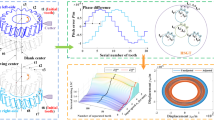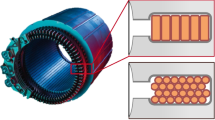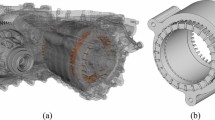Abstract
This paper presents the sensitivity study applied to spur gear heated by induction-heating process by exploring the effect of machine parameters on the hardness profile. The main process parameters, including the power (kW), the heating time (s), and the generator frequency (kHz) are the basic parameters that affect greatly the hardness and ultimately the mechanical performances. This research is made possible by simulation results obtained by coupling electromagnetic field and heat transfer. In order to complete the analysis, three stages are required; first, a Comsol 2D model was built considering the material properties and the machine parameters. Second, the surface temperatures and the case depths are deeply analyzed with the variation of the machine parameters. The relationship between the imposed current density in the coil and the power provided to the heated part is also determined. Finally, the sensitivity of hardness profile with the machine parameters variation was investigated using various statistical tools.
Similar content being viewed by others
References
Grum J, Mater J (2001) A review of the influence of grinding conditions on resulting residual stresses after induction surface hardening and grinding. Processing Technol Proc 114:212–226
Dietmar H, Qingzhe L, Jonathan M-U, Dawid N, Thomas P, Alfred S, Schulz A (2016) Simulation of multi-frequency-induction-hardening including phase transitions and mechanical effects. Finite Elem Anal des 121:86–100
Grum J (2000) Measuring and analysis of residual stresses after induction hardening and grinding. Mater Sci Forum 347-349:453–458
Semiatin SL, Stutz DE (1987) Induction heat treatment for steel, second edn. American society of metal, Ohio
Kai G, Xunpeng Q, Wang Z, Hao C, Zhu S, Liu Y, Song Y (2014) Numerical and experimental analysis of 3D spot induction hardening of AISI 1045 steel. J Mater Process Technol 214(11):2425–2433
Eunkyung L, Brajendra M, Bruce R, Palmer (2016) Effect of heat treatment on wear resistance of Fe–Cr–Mn–C–N high-interstitial stainless steel. Wear 368-369:70–74
Patrice, Gouin O’ Saughnessey,. Martine, Dubé,. Irene Fernandez, Villegas. (2016) Modeling and experimental investigation of induction welding of thermoplastic composites and comparison with other welding processes. J Compos Mater, 0(0) 1–16
Rudnev V, Loveless D, Cook R, Black M (2003) Handbook of induction heating. Marcell Dekker Inc., New York
Vincent S, Hossein M, Florent B, Philippe B (2015) Measurement and correction of residual stress gradients in aeronautical gears after various induction surface hardening treatments. J Mater Process Technol 220:113–123
Smalcerz, A. (2015) The use of multifrequency induction heating for temperature distribution control. Archives of metallurgy and materials, Vol 60, Issue 2.
Jürgen F, Dietmar H (1999) Numerical simulation of the surface hardening of steel. Int J Numer Methods Heat Fluid Flow 9(6):705–724
Magnabosco I (2006) Induction heat treatment of a ISO C45 steel bar: experimental and numerical analysis. Comput Mater Sci 35:98–106
Kawagushi H, Enokizono M, Todaka T (2005) Thermal and magnetic field analysis of induction heating problems. Mater Process Technol 161:193–198
Callister WD Jr, Rethwisch DG (2008) Fundamentals of materials science and engineering. John Wiley, New York
Favennec Y, Labbe V, Bay F (2003) Induction heating processes optimization a general optimal control approach. J Comput Phys 187(1):68–94
Yuan J, Kang J, Rong Y, Sisson RD Jr (2003) FEM modeling of induction hardening process in steel. Worcester polytechnic institute, MA
Sadeghipour K, Dopkin JA, Li K (1996) A computer aided finite element/experimental analysis of induction heating process of steel. Comput Ind 28(3):195–205
Barka N, Bocher P, Brousseau J, Galopin M, Sundararajan S (2007) Modeling and sensitivity study of the induction hardening process. Adv Mater res 15-17:525–530
Barka N, Chebak A, El Ouafi A, Jahazi M, Menou A (2014) A new approach in optimizing the induction heating process using flux concentrators: application to 4340 steel spur gear. J Mater Eng Perform 23(9):3092–3099
Barka N, Bocher P, Brousseau J (2013) Sensitivity study of hardness profile of 4340 specimen heated by induction process using axi-symmetric modeling. Int J Adv Manuf Technol. 69:2747–2756
Ross PJ (1988) Taguchi techniques for quality engineering. McGraw-Hill, New York
Author information
Authors and Affiliations
Corresponding author
Rights and permissions
About this article
Cite this article
Barka, N. Study of the machine parameters effects on the case depths of 4340 spur gear heated by induction—2D model. Int J Adv Manuf Technol 93, 1173–1181 (2017). https://doi.org/10.1007/s00170-017-0586-5
Received:
Accepted:
Published:
Issue Date:
DOI: https://doi.org/10.1007/s00170-017-0586-5




